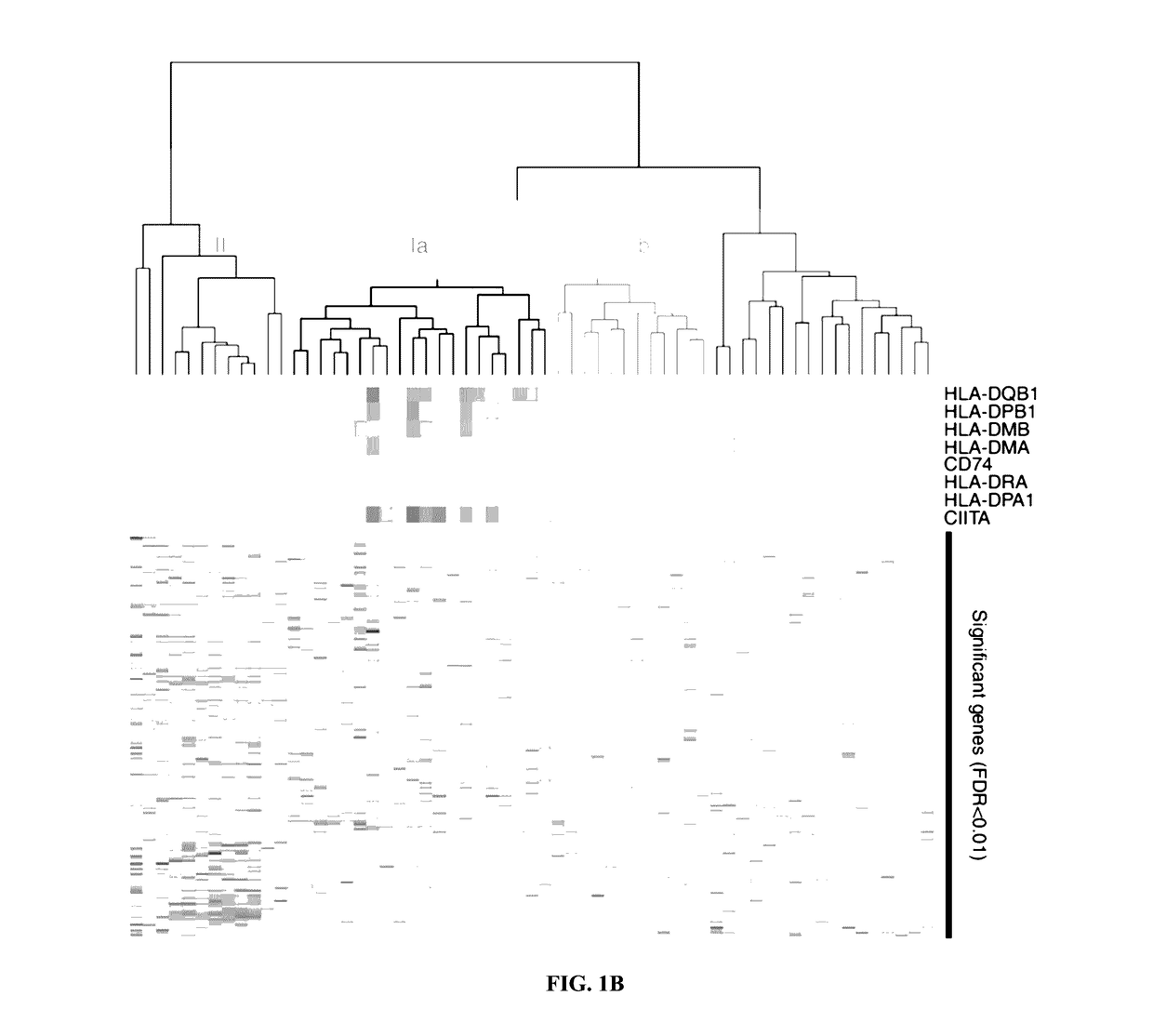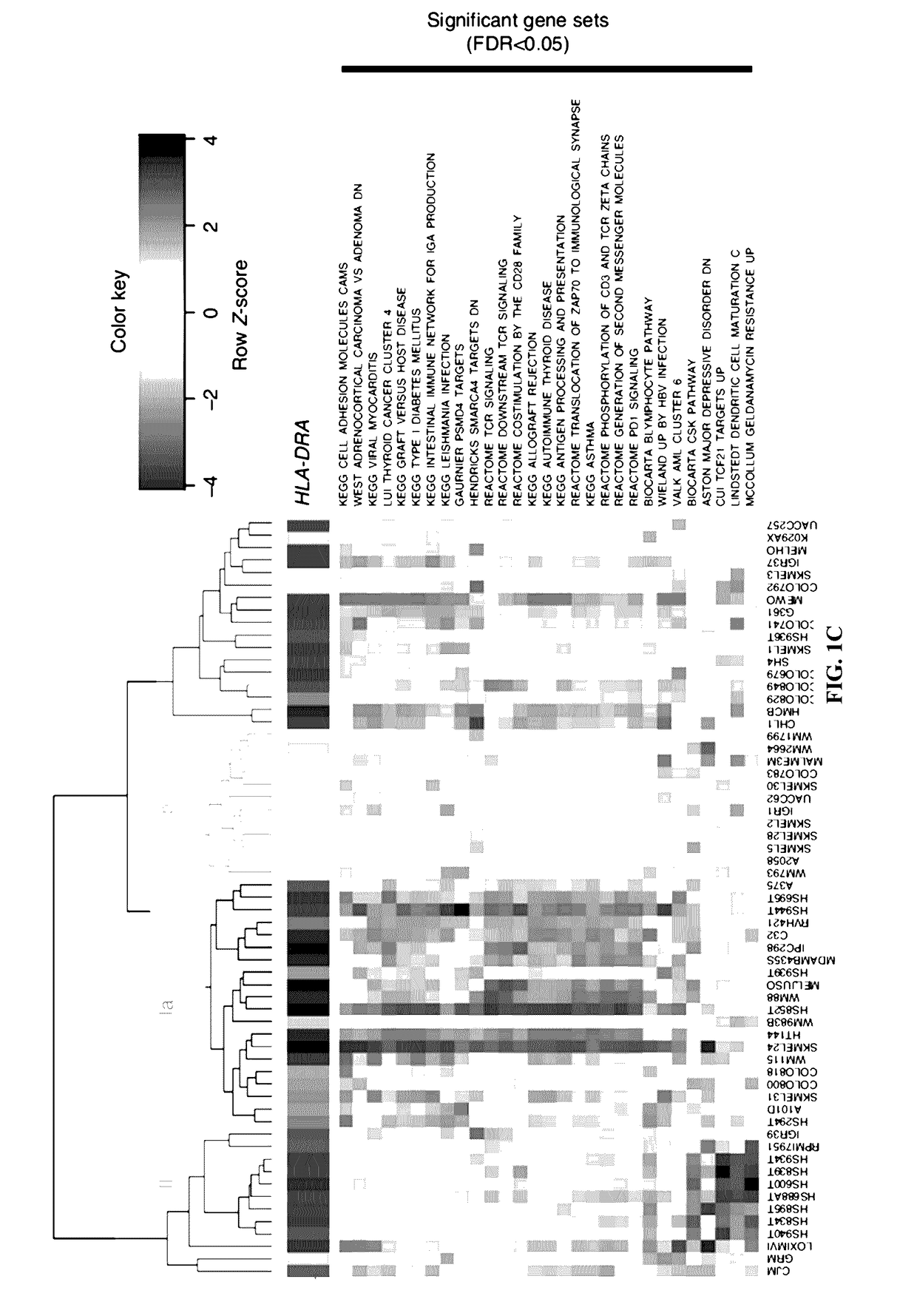Methods and Systems for Predicting Response to Immunotherapies for Treatment of Cancer
- Summary
- Abstract
- Description
- Claims
- Application Information
AI Technical Summary
Benefits of technology
Problems solved by technology
Method used
Image
Examples
example 1
[0063]Melanoma-specific MHC-II expression represents a tumor-autonomous phenotype and predicts response to anti-PD-1 / PD-L1 therapy.
[0064]Abstract
[0065]Anti-PD-1 therapy yields objective clinical responses in 30-40% of advanced melanoma patients. Since most patients do not respond, predictive biomarkers to guide treatment selection are needed. In view thereof, this example examines whether expression is required for tumor antigen presentation and may predict response to anti-PD-1 therapy. Across 60 melanoma cell lines, bimodal expression patterns of MHC-II were found, while MHC-I expression was ubiquitous. A unique subset of melanomas are capable of expressing MHC-II under basal or IFNγ stimulated conditions. Using pathway analysis, it was found that MHC-II(+) cell lines demonstrate signatures of ‘PD-1 signaling’, ‘allograft rejection’, and ‘T-cell receptor signaling’, among others. In two independent cohorts of anti-PD-1-treated melanoma patients, MHC-II positivity on tumor cells wa...
example 2
[0116]Reduced tumor lymphocytic infiltration in the residual disease (RD) of post-neoadjuvant chemotherapy (NAC) triple-negative breast cancers (TNBC) is associated with Ras / MAPK activation and poorer survival.
[0117]Background: Tumor-infiltrating lymphocytes (TILs) are associated with improved prognosis in TNBCs, with several retrospective analyses demonstrating that TNBCs with high baseline TILs have higher rates of pathologic complete response (pCR) to NAC. Moreover, the TIL burden in the RD of patients who do not achieve pCR to NAC is also correlated with prognosis. However, insight into the molecular pathways in TNBC which modulate heterogeneity in host anti-tumor immune responses is lacking. To address this gap in knowledge, TILs were analyzed retrospectively in a cohort of clinically and molecularly characterized TNBCs with RD after NAC.
[0118]Methods: TILs were scored in H&E stained slides by expert pathologists in the post-treatment tumors of 92 NAC-treated TNBC patients with...
example 3
[0123]Preliminary data for use of tumor membrane-specific HLA-DR expression as a biomarker of response to PD-1 / PD-L1 directed therapy.
[0124]Goal: To determine the rate of prediction of tumor cells expressing HLA-DR on response to PD-1 / PD-L1 directed therapy.
[0125]Methods: 12 sections from excisional biopsies or surgical resections of melanoma were immune-stained for HLA-DR (TAL-1B5, commercially available for research from multiple vendors). These 12 sections represented 11 patients; 5 responders to anti-PD-1 / PD-L1 therapy and 6 non-responders. Two samples were from sequential biopsies, one from prior to a clinical response, and one upon acquisition of resistance (relapse) on therapy.
[0126]Tumor sections were stained overnight at 4 C at a 1:1000 dilution. Antigen retrieval was performed using Citrate Buffer (pH6) using a Biocare Dechloaking Chamber. The Visualization System utilized was Envision-Mouse using DAB chromogen and counterstained with Hematoxylin.
[0127]Results: Of 6 non-re...
PUM
| Property | Measurement | Unit |
|---|---|---|
| Angle | aaaaa | aaaaa |
| Interaction | aaaaa | aaaaa |
Abstract
Description
Claims
Application Information
 Login to View More
Login to View More - R&D
- Intellectual Property
- Life Sciences
- Materials
- Tech Scout
- Unparalleled Data Quality
- Higher Quality Content
- 60% Fewer Hallucinations
Browse by: Latest US Patents, China's latest patents, Technical Efficacy Thesaurus, Application Domain, Technology Topic, Popular Technical Reports.
© 2025 PatSnap. All rights reserved.Legal|Privacy policy|Modern Slavery Act Transparency Statement|Sitemap|About US| Contact US: help@patsnap.com



